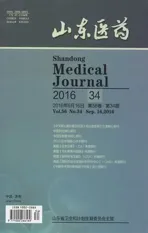姜黄素对TNF-α诱导人结直肠癌细胞上皮间充质转化、迁移的影响
2016-10-19李倩徐春燕彭鹏覃蒙斌李素艳黄杰安
李倩,徐春燕,彭鹏,覃蒙斌,李素艳,黄杰安
(广西医科大学第一附属医院,南宁530021)
·论著·
姜黄素对TNF-α诱导人结直肠癌细胞上皮间充质转化、迁移的影响
李倩,徐春燕,彭鹏,覃蒙斌,李素艳,黄杰安
(广西医科大学第一附属医院,南宁530021)
目的观察姜黄素对肿瘤坏死因子-α(TNF-α)诱导结直肠癌细胞上皮间充质转化(EMT)的影响,并探讨其可能的机制。方法 将人结直肠癌HCT116细胞分为3组,A、B组分别以TNF-α 20 ng/mL、TNF-α 20 ng/mL+姜黄素25 μmol/L干预48 h,C组不干预。采用相差显微镜观察细胞形态变化,划痕实验观察细胞迁移能力,Western blot法检测EMT标记物E-钙黏蛋白(E-cadherin)、波形蛋白(Vimentin)及NF-κB信号通路的p65蛋白。结果 A组细胞多呈具有极性的纺锤状、长梭形,排列疏松,大部分出现细长伪足;B组细长伪足细胞较A组少见,凋落细胞明显多于A组;C组细胞大多数为多边形,细胞间存在一定的间隙,少量细胞出现短粗伪足。A、B、C组细胞迁移距离分别为(319.84±20.93)、(90.70±7.25)、(144.07±11.31)μm,P均<0.05。与C组比较,A组细胞E-cadherin表达减少,Vimentin、p65蛋白表达增加(P均<0.05或0.01);而B组较A组E-cadherin表达增加,Vimentin、p65蛋白表达减少(P均<0.05或0.01)。结论 姜黄素可能通过NF-κB信号通路来抑制TNF-α诱导结直肠癌HCT116细胞的EMT发生、侵袭和转移。
结直肠癌;HCT116细胞;姜黄素;上皮间质转化;核转录因子κB;肿瘤坏死因子
据统计,我国2015年最常见的恶性肿瘤中,结直肠癌在男性中排第5位、女性中排第4位[1]。肿瘤患者绝大部分最终死于肿瘤转移,所以对肿瘤转移的治疗尤为重要。上皮间质转化(EMT)是指在一定的生理和病理情况下,上皮细胞在形态学上向间质细胞表型转变的现象;EMT时肿瘤细胞间排列疏松、大部分出现细长伪足,并出现E-钙黏蛋白(E-cadherin)表达减少、波形蛋白(Vimentin)表达增加。这种转变使肿瘤细胞摆脱细胞间的黏附作用,获得迁移、侵袭能力[2,3]。肿瘤坏死因子-α(TNF-α)能杀伤或抑制肿瘤细胞,但在一定浓度下促进肿瘤细胞发生EMT[4]。本课题组前期研究表明,20 ng/mL的TNF-α可激活NF-κB通路释放p65亚基,促进人结直肠癌细胞HCT116的EMT发生、侵袭和转移[5]。因此,寻找抑制或逆转这一过程的药物很有应用前景。姜黄素是一种从姜科植物姜黄中提取的天然多酚类物质,具有多种生物学作用[6]。文献[7,8]报道,姜黄素通过阻断细胞周期、抑制炎症反应、抗氧化作用及改变肿瘤微环境等多种方式促进结直肠癌细胞的凋亡。但是,姜黄素在结直肠癌中的抗癌作用与EMT之间的调节关系仍不明确。2015年2月~2016年1月,我们观察了姜黄素对HCT116细胞EMT及迁移的影响,并探讨其机制。
1 材料与方法
1.1材料HCT116细胞购自中国科学院细胞库;TNF-α、姜黄素(>99.0%)均购自美国Sigma-Aldrich公司;兔抗人p65和E-cadherin单克隆抗体均购自美国Cell Signaling Technology公司;兔抗人Vimentin购自美国Proteintech公司;鼠抗人GAPDH购自美国Proteintech公司;胎牛血清购自美国ExCell公司;DMEM高糖培养基购自美国Gibco公司。
1.2实验方法
1.2.1HCT116细胞培养将HCT116细胞用含10%胎牛血清的培养液于5% CO2、37 ℃的细胞培养箱中常规培养,待细胞在培养瓶中长至约铺满90%瓶底面积时传代。
1.2.2HCT116细胞EMT形态观察采用相差显微镜。取对数生长期HCT116细胞,消化后制成细胞悬液,以2×104/孔接种至6孔板。细胞贴壁后分为3组,A、B组分别以TNF-α 20 ng/mL、TNF-α 20 ng/mL+姜黄素25 μmol/L干预48 h,C组常规培养不干预。每组分别设3个复孔,相差显微镜观察细胞形态变化并拍照。
1.2.3HCT116细胞迁移能力观察采用细胞划痕实验。取对数生长期HCT116细胞,以3×105/孔接种于6孔板。细胞贴壁后分组与干预同1.2.2,每组设3个平行板。干预48 h后,用高压消毒的200 μL移液器枪头垂直划线;用无菌PBS轻轻冲洗细胞3次,洗脱划下的细胞。加入无血清DMEM高糖培养基,于37 ℃孵育箱常规培养。分别在划线后0、48 h使用倒置显微镜拍照,以迁移距离评价细胞迁移能力。迁移距离=0 h划痕距离-48 h划痕距离。
1.2.4HCT116细胞E-cadherin、Vimentin、p65蛋白检测采用Western blot法。取对数生长期HCT116细胞分别接种于培养瓶中,细胞贴壁后分组与干预同1.2.2。干预48 h后收集各组细胞,加裂解液裂解细胞并提取总蛋白;核酸检测仪测定蛋白质浓度后,各组以每孔40 μg蛋白上样。浓缩胶上电泳电压为60 V,分离胶上电泳电压为100 V,电泳3 h。使用硝酸纤维素膜转膜,用5%脱脂牛奶封闭后分别加E-cadherin蛋白抗体、Vimentin蛋白抗体、p65蛋白抗体和GAPDH抗体4 ℃孵育过夜。以Tris-PBS溶液洗膜5 min×3次,室温下避光孵育二抗1 h;用Tris-PBS溶液洗膜5 min×3次,用Odyssey双色红外荧光扫膜成像。以目的蛋白与GAPDH灰度比值表示各目的蛋白的相对表达量。

2 结果
2.1各组细胞EMT形态变化A组细胞多呈具有极性的纺锤状、长梭形,排列疏松,大部分出现细长伪足;B组细胞呈现过渡形态,纺锤状、长梭形细胞与多边形细胞堆叠,细长伪足细胞较A组少见,凋落细胞明显多于A组;C组细胞大多数为多边形,细胞间存在一定的间隙,少量细胞出现短粗伪足。
2.2各组细胞迁移能力比较 A、B、C组细胞迁移距离分别为(319.84±20.93)、(90.70±7.25)、(144.07±11.31)μm,三组比较P均<0.05。
2.3各组细胞E-cadherin、Vimentin、p65表达比较见表1。

表1 各组细胞E-cadherin、Vimentin、p65相对表达量比较±s)
注:与C组相比,*P<0.05,**P<0.01;与A组相比,△P<0.05,△△P<0.01。
3 讨论
EMT最早于1982年由Greenburg等[9]在晶状体上皮细胞的培养中发现。EMT的过程中,上皮细胞形态具有极性,胞体变得细长,呈纺锤状,长出细长游离的丝状伪足;细胞排列疏松,失去细胞间的黏附力。因此,上皮细胞能逐渐脱离上皮,侵入细胞间,最终向远处组织转移。研究显示,大剂量的TNF-α能通过抑制肿瘤血管起到抗肿瘤作用,而低剂量作用下可以诱导EMT促进多种肿瘤细胞的生长[4,10]。另外,细胞间黏附因子E-cadherin表达下调被认为是EMT的标志[11],以角蛋白为主的细胞骨架变为以Vimentin为主的细胞骨架。本实验结果表明,在TNF-α作用下,HCT116细胞呈现EMT形态学改变,其E-cadherin表达减少、Vimentin表达增加,与上述研究结果一致。
研究发现,EMT的发生与STAT、AKT、NF-κB等多条信号通路有关[2,12,13]。Yan等[14]发现,在结直肠癌细胞中,稳定过表达整合素连接激酶(ILK)能发生EMT;利用NF-κB小干扰RNA作用后,显著增加过表达ILK细胞株的E-cadherin水平。这表明结直肠癌细胞可以通过NF-κB信号通路诱导EMT。TNF-α可以通过激活p38丝裂原活化蛋白激酶(MAPK)[15]和酪氨酸激酶/STAT信号通路促进结直肠癌发生EMT,也能通过活化NF-κB信号通路调节蛋白诱导EMT的发生。
研究认为,姜黄素可通过调节抗氧化反应、免疫反应、凋亡、细胞周期、血管生成等相关蛋白而发挥其抗肿瘤作用[6]。有研究显示,姜黄素能在乳腺癌细胞中通过NF-κB信号通路抑制EMT的发生,从而抑制肿瘤远处转移。但是,姜黄素在结直肠癌中是否通过NF-κB信号通路抑制EMT发生从而抗肿瘤远处转移尚未见报道。本研究结果显示,加入TNF-α的A组细胞间排列疏松、大部分出现细长伪足,肿瘤细胞间的黏附减弱而与细胞外基质黏附增强,本应紧密排列的上皮样结构逐渐向间质细胞形态转变;而加入姜黄素的B组细胞排列较A组紧密,长伪足细胞明显减少。并且,A组细胞较C组迁移距离增加,而B组较A组迁移距离缩短;A组细胞E-cadherin表达下调,Vimentin和NF-κB信号通路p65蛋白表达增加;而加入了姜黄素作用的B组细胞E-cadherin表达减少,Vimentin和NF-κB信号通路p65蛋白表达减少。因此,我们认为,姜黄素可能通过抑制NF-κB信号通路的p65蛋白表达来抑制EMT的发生,进而抑制结直肠癌细胞的运动迁移,从而起到抗肿瘤作用,这为姜黄素治疗癌症提供了又一理论基础。
[1] Chen W, Zheng R, Baade PD, et al. Cancer statistics in China,2015[J]. CA, 2016,66(2):115-1132.
[2] Lee MH, Kachroo P, Pagano PC, et al. Combination treatment with apricoxib and IL-27 enhances inhibition of epithelial-mesenchymal transition in human lung cancer cells through a STAT1 dominant pathway[J]. J Cancer Sci Ther, 2014,6(11):468-477.
[3] Savagner P. The epithelial-mesenchymal transition(EMT) phenomenon[J]. ESMO, 2010,21(7):89-92.
[4] Balkwill F. Tumor necrosis factor or tumor promoting factor[J]. Cyto Grow Fact Rev, 2002,13(2):135-141.
[5] 刘宝玉,黄杰安,刘诗权,等.NF-κB对人结直肠癌细胞上皮间质转化及侵袭转移的影响[J]. 世界华人消化杂志,2014,22(23):3403-3409.
[6] Kumar G, Mittal S, Sak K, et al. Molecular mechanisms underlying chemopreventive potential of curcumin: current challenges and future perspectives[J]. Life Sci, 2016,148(3):313-328.
[7] Lim TG, Lee SY, Huang Z, et al. Curcumin suppresses proliferation of colon cancer cells by targeting CDK2[J]. Cancer Prev Res, 2014,7(4):466-474.
[8] Buhrmann C, Kraehe P, Lueders C, et al. Curcumin suppresses crosstalk between colon cancer stem cells and stromal fibroblasts in the tumor microenvironment: potential role of EMT[J]. PLoS One, 2014,9(9):107514.
[9] Greenburg G,Hay DE. Epithelia duspended in collagen gels can lose characteristics of migrating mesenchymal cellspolarity and express[J]. J Cell Biol, 1982,95(1):333-939.
[10] Bigatto V, De Bacco F, Casanova E, et al. TNF-alpha promotes invasive growth through the MET signaling pathway[J]. Mol oncol, 2015,9(2):377-388.
[11] Guarino M, Rubino B, Ballabio G. The role of epithelial-mesenchymal transition in cancer pathology[J]. Pathology, 2007,39(3):305-318.
[12] Li W, Cao L, Han L, et al. Superoxide dismutase promotes the epithelial-mesenchymal transition of pancreatic cancer cells via activation of the H2O2/ERK/NF-kappaB axis[J]. Int J Oncol, 2015,46(6):2613-2620.
[13] Wang H, Wang HS, Zhou BH, et al. Epithelial-mesenchymal transition (EMT) induced by TNF-alpha requires AKT/GSK-3beta-mediated stabilization of snail in colorectal cancer [J]. PLoS One, 2013,8(2):56664.
[14] Yan Z, Yin H, Wang R, et al. Overexpression of integrin-linked kinase (ILK) promotes migration and invasion of colorectal cancer cells by inducing epithelial-mesenchymal transition via NF-kappaB signaling[J]. Acta Histochem, 2014,116(3):527-533.
[15] Bates RC, Mercurio AM. Tumor necrosis factor alpha stimulates the epithelial-to-mesenchymal transition of human colonic organoids[J]. Mol Biol Cell, 2003,14(5):1790-1800.
Effect of curcumin on epithelial-mesenchymal transition and migration of colorectal cancer cells induced by TNF-α
LIQian,XUChunyan,PENGPeng,QINMengbin,LISuyan,HUANGJiean
(TheFirstAffiliatedHospitalofGuangxiMedicalUniversity,Nanning530021,China)
ObjectiveTo investigate the effect of curcumin on tumor necrosis factor-α (TNF-α)-induced epithelial-mesenchymal transition (EMT) of colorectal cancer HCT116 cells and the possible mechanism. MethodsThe human colorectal cancer HCT116 cells were divided into three groups. Group A and group B were treated with 20 ng/mL TNF-α, 20 ng/mL TNF-α + 25 μmol/L curcumin for 48 h, respectively, and group C with routine culture. Using phase contrast microscope to observe the changes in cell morphology, cell scratch experiments to observed cell migration in each group. Western blotting was used to detect the expression levels of EMT markers E-cadherin, Vimentin and NF-κB signaling pathway-related P65 protein. Results Cells of group A were mostly spindle-shaped, fusiform and loosely arranged and most appeared elongated pseudopodia; in the group B, the slender pseudopodia cells were less, and apoptotic cells were more than those in the group A; most of cells in the group C were polygon, there was a little space between cells, and a few cells appeared stubby pseudopodia. The cell migration distance of groups A, B and C were (319.84±20.93) μm, (90.70±7.25) μm, (144.07±11.31) μm, respectively, and significant difference was found between these three groups (allP<0.05). Compared with group C, the expression of E-cadherin in cells of group A was decreased, however, the expression of Vimentin and p65 protein was increased; and compared with group A, the expression of E-cadherin in cells of group B was increased, the expression of Vimentin and p65 protein was reduced. ConclusionCurcumin inhibited the occurrence, development and metastasis of TNF-α-induced EMT in HCT116 colorectal cancer cells probably through NF-κB signaling pathway.
colorectal carcinoma; HCT116 cells; curcumin; epithelial-mesenchymal transition; nuclear transcription factor-κB; tumor necrosis factor
国家自然科学基金资助项目(81260365);广西中医药民族医药自筹经费科研课题项目(GZZC14-57)。
李倩(1990-),女,硕士研究生,主要研究方向为消化道肿瘤的分子机制。E-mail: qiandeyu19@163.com
简介:黄杰安(1965-),男,教授,主任医师,博士生导师,主要研究方向为消化道肿瘤的分子机制。E-mail: 1404991727@qq.com
10.3969/j.issn.1002-266X.2016.34.001
735.3
A
1002-266X(2016)34-0001-03
2016-03-28)
